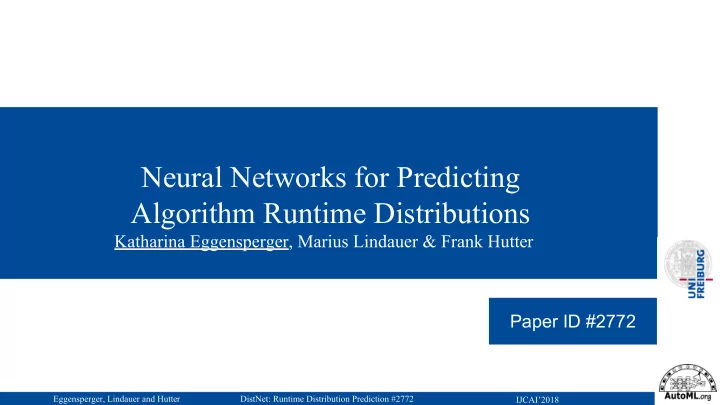

Neural Networks for Predicting Algorithm Runtime Distributions Katharina Eggensperger, Marius Lindauer & Frank Hutter Paper ID #2772 Eggensperger, Lindauer and Hutter DistNet: Runtime Distribution Prediction #2772 IJCAI’2018
Motivation Algorithm portfolios yield state-of-the-art performance for SAT, ASP, Planning, … → to build these we can make use of runtime predictions Other applications: ● Optimal restarts ● Algorithm selection ● Algorithm configurations Eggensperger, Lindauer and Hutter DistNet: Runtime Distribution Prediction #2772 2 IJCAI’2018
Describing the Runtime of an Algorithm? solve(instance, seed): # do something return solution, runtime runtime Eggensperger, Lindauer and Hutter DistNet: Runtime Distribution Prediction #2772 3 IJCAI’2018
Describing the Runtime of an Algorithm? solve(instance, seed): # do something return solution, runtime runtime Eggensperger, Lindauer and Hutter DistNet: Runtime Distribution Prediction #2772 3 IJCAI’2018
Contributions 1 Study how to predict parametric RTDs 2 Propose DistNet , a practical neural network for predicting RTDs 3 Evaluate DistNet and show that it can learn from only a few samples per instance Eggensperger, Lindauer and Hutter DistNet: Runtime Distribution Prediction #2772 4 IJCAI’2018
Typical Pipeline for Runtime prediction Eggensperger, Lindauer and Hutter DistNet: Runtime Distribution Prediction #2772 5 IJCAI’2018
Typical Pipeline for Runtime prediction Eggensperger, Lindauer and Hutter DistNet: Runtime Distribution Prediction #2772 5 IJCAI’2018
Typical Pipeline for Runtime prediction Eggensperger, Lindauer and Hutter DistNet: Runtime Distribution Prediction #2772 5 IJCAI’2018
Typical Pipeline for Runtime prediction Eggensperger, Lindauer and Hutter DistNet: Runtime Distribution Prediction #2772 5 IJCAI’2018
Typical Pipeline for Runtime prediction Eggensperger, Lindauer and Hutter DistNet: Runtime Distribution Prediction #2772 6 IJCAI’2018
Empirical RTDs Clasp-factoring LPG-Zenotravel SAPS-CV-VAR p(solved by this time) Eggensperger, Lindauer and Hutter DistNet: Runtime Distribution Prediction #2772 7 IJCAI’2018
Typical Pipeline for Runtime prediction Eggensperger, Lindauer and Hutter DistNet: Runtime Distribution Prediction #2772 8 IJCAI’2018
Considered Parametric Distribution Eggensperger, Lindauer and Hutter DistNet: Runtime Distribution Prediction #2772 9 IJCAI’2018
Quantifying the Quality of Runtime Distributions (1) observed runtimes distribution parameter Eggensperger, Lindauer and Hutter DistNet: Runtime Distribution Prediction #2772 10 IJCAI’2018
Quantifying the Quality of Runtime Distributions (1) observed runtimes distribution parameter (2) Eggensperger, Lindauer and Hutter DistNet: Runtime Distribution Prediction #2772 10 IJCAI’2018
Typical Pipeline for Runtime prediction Eggensperger, Lindauer and Hutter DistNet: Runtime Distribution Prediction #2772 11 IJCAI’2018
Predicting multiple Runtime Distributions Option 1 For each training instance → fit the parametric distribution’s parameter on observed runtimes. Then for all training instances, for each distribution parameter: fit a model Eggensperger, Lindauer and Hutter DistNet: Runtime Distribution Prediction #2772 12 IJCAI’2018
Predicting multiple Runtime Distributions Option 1 For each training instance → fit the parametric distribution’s parameter on observed runtimes. Then for all training instances, for each distribution parameter: fit a model Problematic, because models ● can only be as good as each fitted distribution ● do not know about interaction between their outputs ● typically minimize loss in the parameter space Eggensperger, Lindauer and Hutter DistNet: Runtime Distribution Prediction #2772 12 IJCAI’2018
Predicting multiple Runtime Distributions Option 2 For each training instance → fit the parametric distribution’s parameter on observed runtimes. Then for all training instances, for each distribution parameter: fit a model with multiple outputs Problematic, because model ● can only be as good as each fitted distribution ● does not know about interaction between their outputs ● typically minimizes loss in the parameter space Eggensperger, Lindauer and Hutter DistNet: Runtime Distribution Prediction #2772 12 IJCAI’2018
Predicting multiple Runtime Distributions DistNet For each training instance → fit the parametric distribution’s parameter on observed runtimes. Then for all training instances, for each distribution parameter: fit a neural network using negative log-likelihood as a loss function Eggensperger, Lindauer and Hutter DistNet: Runtime Distribution Prediction #2772 12 IJCAI’2018
Results We compared ● DistNet ● independent Random Forests (iRF) ● multi-output Random Forests (mRF) on 7 scenarios from SAT solving and AI planning. [...] Table : Averaged negative log-likelihood achieved for predicting RTDs for Figure : Averaged negative log-likelihood. Smaller values are better. unseen instances Eggensperger, Lindauer and Hutter DistNet: Runtime Distribution Prediction #2772 16 IJCAI’2018
Results We compared ● DistNet ● independent Random Forests (iRF) ● multi-output Random Forests (mRF) on 7 scenarios from SAT solving and AI planning. [...] Table : Averaged negative log-likelihood achieved for predicting RTDs for Figure : Averaged negative log-likelihood. Smaller values are better. unseen instances Eggensperger, Lindauer and Hutter DistNet: Runtime Distribution Prediction #2772 16 IJCAI’2018
Results We compared ● DistNet ● independent Random Forests (iRF) ● multi-output Random Forests (mRF) on 7 scenarios from SAT solving and AI planning. [...] → Predicting parameters for RTDs is possible → Joint predictions work better → DistNet provides more robust predictions which are often better than those of Table : Averaged negative log-likelihood achieved for predicting RTDs for Figure : Averaged negative log-likelihood. Smaller values are better. unseen instances competitors Eggensperger, Lindauer and Hutter DistNet: Runtime Distribution Prediction #2772 16 IJCAI’2018
DistNet on a Low Number of Observations multi-ouput Random Forest averaged NLLH DistNet Distribution fitted on all samples Eggensperger, Lindauer and Hutter DistNet: Runtime Distribution Prediction #2772 17 IJCAI’2018
Wrap-Up We have proposed DistNet, which + jointly learns distribution parameters + directly optimizes the loss function of interest + performs well even if only few observations per instance are available Eggensperger, Lindauer and Hutter DistNet: Runtime Distribution Prediction #2772 18 IJCAI’2018
Wrap-Up We have proposed DistNet, which + jointly learns distribution parameters + directly optimizes the loss function of interest + performs well even if only few observations per instance are available Open Questions: - How to automatically determine a well fitting distribution family? - How to handle heterogeneous datasets? Eggensperger, Lindauer and Hutter DistNet: Runtime Distribution Prediction #2772 18 IJCAI’2018
Wrap-Up We have proposed DistNet, which + jointly learns distribution parameters + directly optimizes the loss function of interest + performs well even if only few observations per instance are available Open Questions: - How to automatically determine a well fitting distribution family? - How to handle heterogeneous datasets? Code and data: https://www.automl.org/distnet/ Eggensperger, Lindauer and Hutter DistNet: Runtime Distribution Prediction #2772 18 IJCAI’2018
Recommend
More recommend